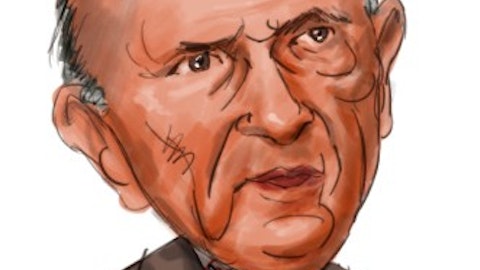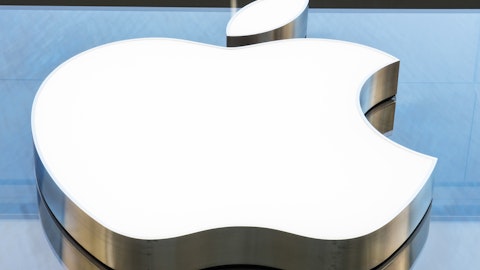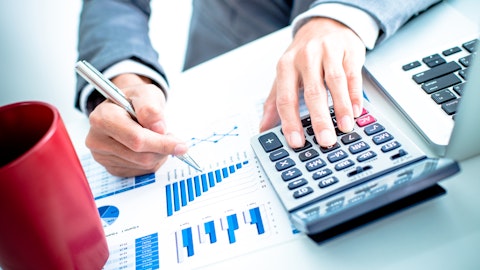Warren Buffett’s newest 13F filings were recently released…
The Oracle of Omaha has invested in another tech company. This is only Buffett’s 2nd large technology company investment. The first came in 2011.
That’s when Warren Buffett began building a position in International Business Machines Corp (IBM). Today, IBM is Berkshire Hathaway’s (BRK.A) 4th largest holding – 9.6% of the company’s total stock portfolio.
Buffett has famously (prior to 2011) avoided tech stocks. When asked in the late 1990’s if he was (at the time) investing in technology stocks, Warren Buffett said the following:
“The answer is no, and it’s probably unfortunate. I don’t know what that world will look like in 10 years, and I don’t want to play in a game where the other guy has an advantage over me.”
Buffett appears to have studied up on technology stocks since the late 1990’s. It is interesting to note that he only invested in International Business Machines Corp (IBM) when it:
1. Traded at a low price-to-earnings multiple
2. Paid a dividend
3. Heavily engaged in share buybacks
His recent investment in Apple Inc. (NASDAQ:AAPL) follows the same pattern. Apple is currently trading for a price-to-earnings ratio of 10.5, has a 2.4% dividend yield, and a $175 billion (yes, you read that right) share repurchase program in place.
Buffett will join 133 other investors in Insider Monkey’s database which were long Apple on December 31. Those investors held $17.72 billion worth of the company’s shares at that time, which only amounted to 3.0% of its float. There appears to have been a big move into Apple during the first quarter as its shares become even more attractive from a valuation perspective throughout the first two months of the year. We count 32 hedge funds as taking up new long positions in the stock during the quarter, while 21 closed sold out of their previous holdings. That could vault Apple back into the top-5 most owned stocks among the funds in our database, after it fell to sixth at the end of 2015.

Did Buffett Really Invest in Apple?
There’s no doubt that Buffett was behind the International Business Machines Corp (IBM) investment. It makes up nearly 10% of his portfolio.
In Buffett’s 2015 annual report, he gave an update about the control both Todd Combs and Ted Weschler have over Berkshire’s (BRK.B) portfolio:
“Todd (Combs) and Ted Weschler are primarily investment managers – they each handle about $9 billion for us – both of them cheerfully and ably add major value to Berkshire in other ways as well. Hiring these two was one of my best moves.”
With a combined portfolio value of around $18 billion, it is conceivable that the Apple investment came from one or both of Ted Weschler and Todd Combs.
Regardless, Berkshire Hathaway has invested around a bit over $1 billion into Apple stock. This makes up around 0.8% of Berkshire’s total portfolio.
Follow Warren Buffett's Berkshire Hathaway
What Is Strange About Buffett’s Apple Investment
If you look at Warren Buffett’s portfolio, you will see it is filled with high quality businesses with long histories of success.
These are businesses that have proven they can grow and prosper over the long-run. The founding date of his top 5 holdings (which make up 69% of his total portfolio) are discussed below:
Kraft Heinz Co (NASDAQ:KHC): The company was recently created through a merger. Kraft traces its history back to the late 1800’s and early 1900’s:
– L. Kraft started his cheese business in 1903
– W. Post started Postum Cereal in 1895
– Oscar Meyer started his meat business in 1883
H.J. Heinz Company was founded in 1869 by its namesake, Henry John Heinz.
Wells Fargo & Co (NYSE:WFC): Henry Wells & William Fargo founded Wells Fargo in 1852.
The Coca-Cola Co (NYSE:KO): The first Coca-Cola was created in 1886 by Dr. John Pemberton in Atlanta, Georgia.
International Business Machines (IBM): IBM traces its roots back to 1911. It began life by the less grandiose name Computer-Tabulating-Recording-Company.
American Express Company (NYSE:AXP): American Express is the oldest of the 5, tracing its history all the way back to 1850.
The average founding year of Buffett’s top 5 holdings is 1876 – the same year the first telephone call was made.
Looking at these holdings, it is clear Warren Buffett looks for a very long history of sustained success. This is where Apple does not fit the traditional Buffett stock.
Apple was founded in 1976. The company does not have a sustained history of success. In 1997, Apple was bailed out of bankruptcy by a $150 million investment from Microsoft Corporation (NASDAQ:MSFT).
Apple did not become the Apple we know today until 2001, when the first iPod was released. The iPod’s success launched the iPhone, iPad, iTunes, and Apple Watch.
Today, Apple Inc. (NASDAQ:AAPL) is the largest corporation in the world based on both market cap and earnings:
– $518 billion market cap
– $50.7 billion (!) in earnings over the last 12 months
But Apple’s success is recent and came quickly. It does not match the slow gradual growth of Buffett’s other large holdings.
This makes me think that the Apple investment is a large bet (relative to the size of the portfolio they control) by either Todd Combs or Ted Weschler.
Apple Is A High Quality Shareholder Friendly Business
I look for high quality dividend growth stocks suitable for long-term holding. There’s no doubt Apple is a high quality dividend growth stock today.
Apple reinstated its dividend in 2012 (the company hadn’t paid a dividend since 1995). The company’s dividend history is shown below:

Notes: 2012 dividend is annualized, 2016 dividend is annualized
What’s more, the company has repurchased over 5% a year on average of its shares each year from 2012 through 2015.
Apple currently has a dividend yield of 2.4%. The company’s dividend yield combined with its share repurchases gives it a shareholder yield of around 7.5% – which is extremely high. There’s no doubt Apple is a shareholder friendly company.
Apple’s ability to generate cash – $50 billion in earnings over the last 12 months – makes it very clear the company has a strong brand based competitive advantage.
The company’s products and brand represents quality. Apple’s products are used and greatly improve the lives of 100’s of millions of people.
What isn’t clear about Apple is the sustainability of its competitive advantage.
Will we be using credit (American Express), eating Ketchup (Kraft-Heinz), and drinking beverages (Coca-Cola) in 10 years? With a very high degree of certainty, you can say yes to all of the above.
Will Apple still be the world’s dominant smart phone company in 10 years? What about 20 years? Will we even use smart phones in 20 years? The answer to those questions are much less certain.
That’s where the uncertainty in an Apple investment lies. It’s not whether or not the company is shareholder friendly and has a strong competitive advantage today (it most certainly does. It is about whether that competitive advantage is durable and sustainable.
Apple’s Valuation & Final Thoughts
One thing is clear about Apple stock. The market has priced in fears about the company’s future. Apple is currently trading for a price-to-earnings ratio of 10.5 and a forward price-to-earnings ratio of 10.3
The fears outlined in this article are just as applicable to Netflix, Inc. (NASDAQ:NFLX), Alphabet Inc (NASDAQ:GOOG), and Facebook Inc (NASDAQ:FB) as they are to Apple. The forward price-to-earnings ratios of those 3 businesses (all of which have strong competitive advantages today) are shown below:
– Google has a forward price-to-earnings ratio of 18.1
– Netflix has a forward price-to-earnings ratio of 84.9
– Facebook has a forward price-to-earnings ratio of 26.0
Apple Inc. (NASDAQ:AAPL) stock is heavily discounted today. There’s very little doubt the company’s brand based competitive advantage will be sustained over the next several years.
At a price-to-earnings ratio of 10.5, Apple makes an excellent value investment for investors with a medium (say 2 to 3 year) time frame. When investor sentiment around Apple changes (and it likely will at some point), those who purchased Apple at a price-to-earnings ratio of 10.5 should see large gains.
Is Apple a core position for the long-term dividend growth investors? Not in my analysis.
Does Apple offer above-average risk-adjusted return potential over the next several years? Absolutely.
Follow Apple Inc. (NASDAQ:AAPL)
Follow Apple Inc. (NASDAQ:AAPL)
Receive real-time insider trading and news alerts
Disclosure: None





